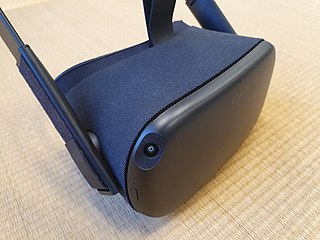
Virtual reality (VR) is a simulated experience that employs 3D near-eye displays and pose tracking to give the user an immersive feel of a virtual world. Applications of virtual reality include entertainment, education and business. VR is one of the key technologies in the reality-virtuality continuum. As such, it is different from other digital visualization solutions, such as augmented virtuality and augmented reality.

Oculus Rift is a discontinued line of virtual reality headsets developed and manufactured by Oculus VR, a virtual reality company founded by Palmer Luckey that is widely credited with reviving the virtual reality industry. It was the first virtual reality headset to provide a realistic experience at an accessible price, utilizing novel technology to increase quality and reduce cost by orders of magnitude compared to earlier systems. The first headset in the line was the Oculus Rift DK1, released on March 28, 2013. The last was the Oculus Rift S, discontinued in April 2021.
Eve: Valkyrie was a multiplayer dogfighting shooter game set in the Eve Online universe that was designed to use virtual reality headset technology. Originally launched for Microsoft Windows for use with the Oculus Rift virtual reality headset, CCP Games had announced they plan to enable cross-platform play between the three major VR systems: the Oculus Rift, the HTC Vive, and the PlayStation VR. Released in March 2016, the game had two game mode options: Chronicles could be played in single player, while Combat allowed eight by eight combat PvP missions. Reviews generally criticized the limited plot and limitations of single player mode, although the described "arcade experience" was praised for having intuitive controls and "exhilarating" dogfighting features, with PC Powerplay dubbing it "arguably the best VR experience currently available for the [Oculus Rift] platform."

Reality Labs, originally Oculus VR, is a business and research unit of Meta Platforms that produces virtual reality (VR) and augmented reality (AR) hardware and software, including virtual reality headsets such as Quest, and online platforms such as Horizon Worlds. In June 2022, several artificial intelligence (AI) initiatives that were previously a part of Meta AI were transitioned to Reality Labs. This also includes Meta's fundamental AI Research laboratory FAIR which is now part of the Reality Labs - Research (RLR) division.

HTC Vive is a line of virtual and mixed reality headsets produced by HTC Corporation. The brand currently encompasses headsets designed for use with personal computers as well as standalone headsets such as the Vive Focus line, Vive Flow glasses, and the Vive Elite XR mixed reality headset.

Steam Link is a hardware and software product developed by Valve Corporation for streaming Steam content from a personal computer or Steam Machine wirelessly to a mobile device or other monitor. Steam Link was originally released as a hardware device alongside the debut of Steam Machines in November 2015. Valve discontinued the Steam Link hardware device in November 2018, in favor of supporting its software-based Steam Link application for mobile devices and smart televisions, as well as providing Steam Link as a software package for the Raspberry Pi microcomputer.
Oculus Touch is a line of motion controller systems used by Meta Platforms virtual reality headsets. The controller was first introduced in 2016 as a standalone accessory for the Oculus Rift CV1, and began to be bundled with the headset and all future Oculus products beginning in July 2017. Since their original release, Touch controllers have undergone revisions for later generations of Oculus/Meta hardware, including a switch to inside-out tracking, and other design changes.

A virtual reality headset is a head-mounted device that uses 3D near-eye displays and positional tracking to provide a virtual reality environment for the user. VR headsets are widely used with VR video games, but they are also used in other applications, including simulators and trainers. VR headsets typically include a stereoscopic display, stereo sound, and sensors like accelerometers and gyroscopes for tracking the pose of the user's head to match the orientation of the virtual camera with the user's eye positions in the real world.

AltspaceVR was a social VR platform that was founded in 2013 by Eric Romo and launched its initial product in May 2015. In 2017 it was acquired by Microsoft and became part of the Mixed Reality division within the Cloud and AI group. Some elements of the platform appear in Microsoft Mesh.

A virtual reality game or VR games is a video game played on virtual reality (VR) hardware. Most VR games are based on player immersion, typically through head-mounted display unit or headset with stereoscopic displays and one or more controllers.

VRChat is an online virtual world platform created by Graham Gaylor and Jesse Joudrey and operated by VRChat, Inc. The platform allows users to interact with others with user-created 3D avatars and worlds. VRChat is designed primarily for use with virtual reality headsets, being available for Microsoft Windows PCs and as a native app for Android-based headsets such as Meta Quest, Pico 4, and HTC Vive XR Elite. It is also usable without VR in a "desktop" mode designed for either a mouse and keyboard or gamepad, and in an Android app for touchscreen devices.

The Oculus Go is a standalone virtual reality headset developed by Meta Reality Labs in partnership with Qualcomm and Xiaomi. It is in the first generation of Facebook Technologies' virtual reality headsets, and the company's first device in the category of standalone VR headsets, which was a new category at the time of the Go's release. The Oculus Go was unveiled on October 11, 2017 during the Oculus Connect developer conference, and released on May 1, 2018. Xiaomi launched their own version of the headset in China as the Mi VR Standalone on May 31, 2018.

The first-generation Oculus Quest is a discontinued virtual reality headset developed by Oculus, a brand of Facebook Inc., and released on May 21, 2019. Similar to its predecessor, Oculus Go, it is a standalone device, that can run games and software wirelessly under an Android-based operating system. It supports positional tracking with six degrees of freedom, using internal sensors and an array of cameras in the front of the headset rather than external sensors. The cameras are also used as part of the safety feature "Passthrough", which shows a view from the cameras when the user exits their designated boundary area known as "Guardian". A later software update added "Oculus Link", a feature that allows the Quest to be connected to a computer via USB, enabling use with Oculus Rift-compatible software and games.

Oculus Rift S is a discontinued virtual reality headset co-developed by Lenovo Technologies and Oculus VR. Announced in March 2019 and released that May, it is a successor to the original Oculus Rift CV1 model, with noted changes including a new "inside-out" positional tracking system with cameras embedded inside the headset unit, a higher-resolution display, and a new "halo" head strap.

Oculus Rift CV1, also known simply as Oculus Rift, is a virtual reality headset developed by Oculus VR, a subsidiary of Meta Platforms, known at the time as Facebook Inc. It was announced in January 2016, and released in March the same year. The device constituted the first commercial release in the Oculus Rift lineup.

NeosVR is a free-to-play, massively multiplayer online, virtual reality application created by Solirax. It was released for free on Microsoft Windows via Steam on May 4, 2018, with support for several VR headsets.

The Quest 2 is a virtual reality (VR) headset developed by Reality Labs, a division of Meta Platforms. It was unveiled on September 16, 2020, and released on October 13, 2020 as the Oculus Quest 2. It was then rebranded as the Meta Quest 2 in 2022, as part of a company-wide phase-out of the Oculus brand following the rebranding of Facebook, Inc. as Meta.
The Meta Quest Pro is a mixed reality (MR) headset developed by Reality Labs, a division of Meta Platforms.
VIVE XR Elite is an extended reality (XR) headset developed and manufactured by HTC. Released in February 2023, the headset combines virtual reality (VR) and mixed reality (MR) functionalities.












